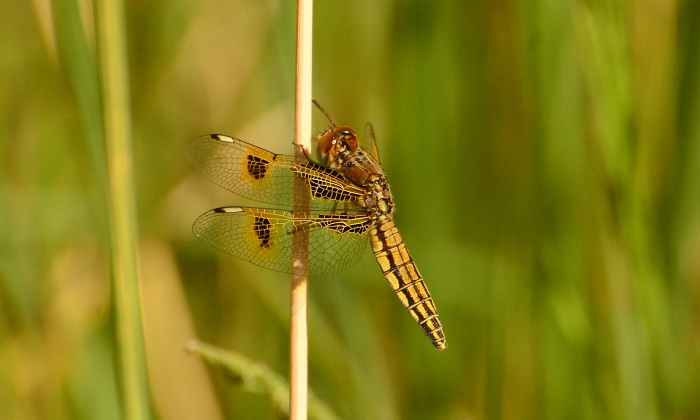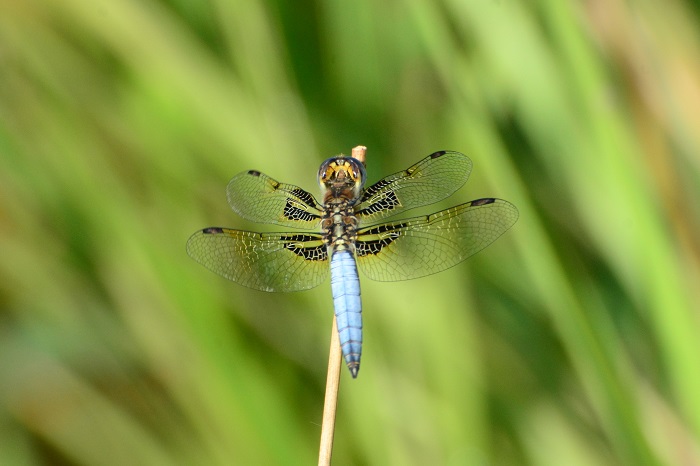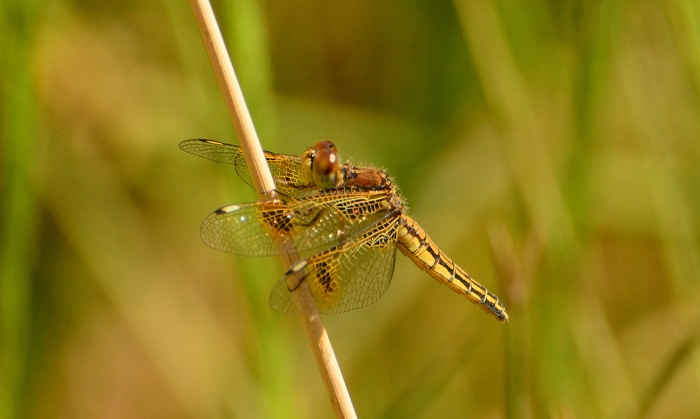Cover photo by Peter Webb.
Find this species in the FBIS database (Freshwater Biodiversity Information System) here.
Family Libellulidae
Identification

Mkuze River, KwaZulu-Natal
Photo by Ryan Tippett
Very Small
Length up to 27mm; Wingspan reaches 42mm.
Both sexes of the Yellow-veined Widow possess distinctive colouration. This, along with their small size and squat build, renders them unlike any other species in the region. Males and females have richly patterned black, brown, and yellow wings.
Click here for more details on identification.

St. Lucia, KwaZulu-Natal
Photo by Ryan Tippett
Habitat
The Yellow-veined Widow favours the marshy fringes of streams and rivers, but it is also commonly found at seeps and vleis with an abundance of grasses. The Yellow-veined Widow is more common inland than along the coast.

Near Himeville, KwaZulu-Natal
Photo by Corné Rautenbach
Behaviour
The Yellow-veined Widow is an inconspicuous species due to its small size and habit of flitting low between grass tufts. Males, however, often perch at the top of a grass stem. The Yellow-veined Widow has a slow fluttering flight on cool days and a faster darting flight when it is hot. They are often gregarious when they occur in good numbers, and both sexes occur in the same vicinity.
Status and Conservation
Palpopleura jucunda is a common but localised species in South Africa. It is listed as of Least Concern in the IUCN Red List of Threatened Species. The Yellow-veined Widow is a fairly tolerant species and occurs widely at both natural and man-made sites.

Seweweekspoort, Western Cape
Photo by Ryan Tippett
Distribution
The Yellow-veined Widow is native to sub-Saharan Africa but is most widespread in eastern, south-central and southern Africa. It occurs from Ethiopia in the north, right down to the southern tip of Africa in the Western Cape.
Below is a map showing the distribution of records for Yellow-veined Widow in the OdonataMAP database as at February 2020.

Below is a map showing the distribution of records for Yellow-veined Widow in the OdonataMAP database as of December 2024.

The next map below is an imputed map, produced by an interpolation algorithm, which attempts to generate a full distribution map from the partial information in the map above. This map will be improved by the submission of records to the OdonataMAP section of the Virtual Museum.


Ultimately, we will produce a series of maps for all the odonata species in the region. The current algorithm is a new algorithm. The objective is mainly to produce “smoothed” maps that could go into a field guide for odonata. This basic version of the algorithm (as mapped above) does not make use of “explanatory variables” (e.g. altitude, terrain roughness, presence of freshwater — we will be producing maps that take these variables into account soon). Currently, it only makes use of the OdonataMAP records for the species being mapped, as well as all the other records of all other species. The basic maps are “optimistic” and will generally show ranges to be larger than what they probably are.
These maps use the data in the OdonataMAP section of the Virtual Museum, and also the database assembled by the previous JRS funded project, which was led by Professor Michael Samways and Dr KD Dijkstra.

Mkuze River, KwaZulu-Natal
Photo by Ryan Tippett
Further Resources
The use of photographs by Corné Rautenbach and Peter Webb is acknowledged. Other photographs by Ryan Tippett.
Yellow-veined Widow Palpopleura jucunda Rambur, 1842
Other common names: Geelaarweetjie (Afrikaans)
Recommended citation format: Loftie-Eaton M; Navarro R; Tippett RM; Underhill L. 2025. Yellow-veined Widow Palpopleura jucunda. Biodiversity and Development Institute. Available online at https://thebdi.org/2020/05/13/yellow-veined-widow-palpopleura-jucunda/
References: Tarboton, M; Tarboton, W. (2019). A Guide to the Dragonflies & Damselflies of South Africa. Struik Nature.
Samways, MJ. (2008). Dragonflies and Damselflies of South Africa. Pensoft
Samways, MJ. (2016). Manual of Freshwater Assessment for South Africa: Dragonfly Biotic Index. Suricata 2. South African National Biodiversity Institute, Pretoria
Martens, A; Suhling, F. (2007). Dragonflies and Damselflies of Namibia. Gamsberg Macmillan.

Seweweekspoort, Western Cape
Photo by Ryan Tippett

